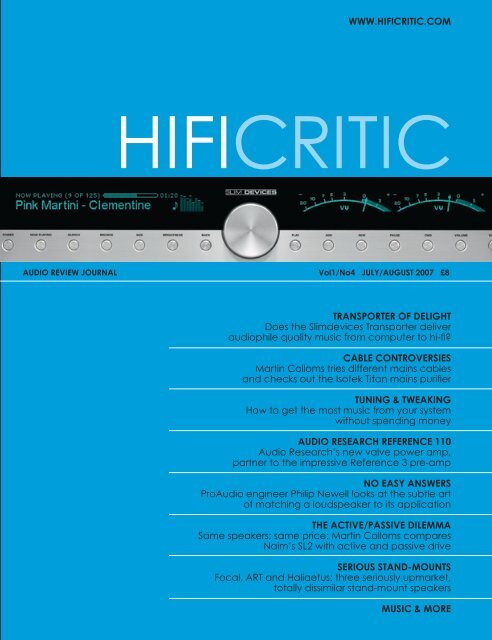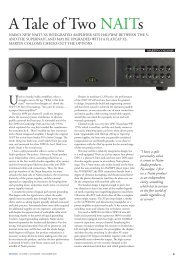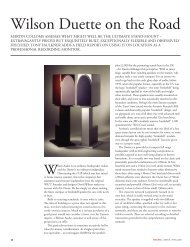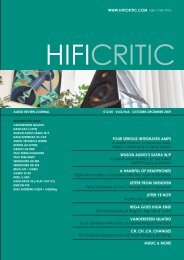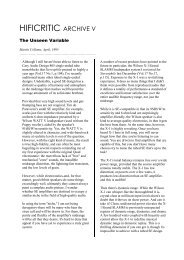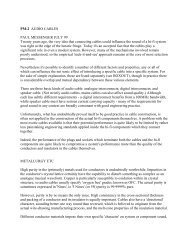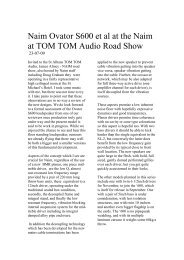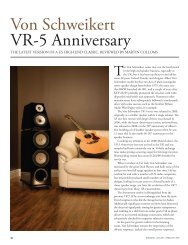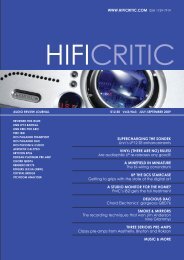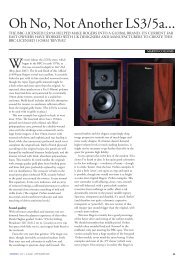HFC_issue4 8.indd - Hificritic.com
HFC_issue4 8.indd - Hificritic.com
HFC_issue4 8.indd - Hificritic.com
Create successful ePaper yourself
Turn your PDF publications into a flip-book with our unique Google optimized e-Paper software.
WWW.HIFICRITIC.COM<br />
HIFICRITIC<br />
AUDIO REVIEW JOURNAL Vol1/No4 JULY/AUGUST 2007 £8<br />
TRANSPORTER OF DELIGHT<br />
Does the Slimdevices Transporter deliver<br />
audiophile quality music from <strong>com</strong>puter to hi-fi?<br />
CABLE CONTROVERSIES<br />
Martin Colloms tries different mains cables<br />
and checks out the Isotek Titan mains purifier<br />
TUNING & TWEAKING<br />
How to get the most music from your system<br />
without spending money<br />
AUDIO RESEARCH REFERENCE 110<br />
Audio Research’s new valve power amp,<br />
partner to the impressive Reference 3 pre-amp<br />
NO EASY ANSWERS<br />
ProAudio engineer Philip Newell looks at the subtle art<br />
of matching a loudspeaker to its application<br />
THE ACTIVE/PASSIVE DILEMMA<br />
Same speakers; same price: Martin Colloms <strong>com</strong>pares<br />
Naim’s SL2 with active and passive drive<br />
SERIOUS STAND-MOUNTS<br />
Focal, ART and Haliaetus: three seriously upmarket,<br />
totally dissimilar stand-mount speakers<br />
MUSIC & MORE<br />
HIFICRITIC JULY / AUGUST 2007 1
HIFICRITIC<br />
Vol1 | No4 July | August 2007<br />
Editor | Paul Messenger<br />
Writers<br />
Chris Binns<br />
Christopher Breunig<br />
Chris Bryant<br />
Martin Colloms<br />
Nigel Finn<br />
George Foster<br />
Jon Honeyball<br />
Philip Newell<br />
Malcolm Steward<br />
Paul Messenger<br />
Publisher | Martin Colloms<br />
Design | Philippa Steward<br />
Published by<br />
HIFICRITIC Ltd<br />
P O Box 59214<br />
London NW3 9EZ<br />
info@hificritic.<strong>com</strong><br />
www.hificritic.<strong>com</strong><br />
Printed in the UK by<br />
Scottish County Press, Edinburgh<br />
Printed copies are available bi-monthly in<br />
January, March, May, July, September and<br />
November by subscription only.<br />
© HIFICRITIC Ltd 2007. All rights reserved.<br />
Any unauthorised editing, copying, reselling<br />
or distribution of the whole or part of<br />
this publication is prohibited. The views<br />
expressed in any articles in this magazine<br />
should be taken as those of the author or<br />
the person quoted unless indicated to the<br />
contrary. While HIFICRITIC endeavours to<br />
ensure the accuracy of the information<br />
contained in this publication, its accuracy<br />
cannot be guaranteed and HIFICRITIC.COM<br />
accepts no liability for any use of, reliance<br />
on or the accuracy of such information.<br />
Several features in this issue merit further Editorial discussion, but after some<br />
thought I’ve decided draw particular attention to Martin Colloms’ piece on<br />
mains electricity connection.<br />
Because it proved virtually impossible to predict how any particular cable would<br />
perform, irrespective of price or ‘features’, one inescapable but nonetheless interesting<br />
conclusion from the mains cable <strong>com</strong>parisons is that we still have a great deal to learn<br />
about how mains leads and mains electricity interact with hi-fi systems. A couple of<br />
personal anecdotes will put some more flesh on the bones.<br />
I was particularly interested by Martin’s work with the IsoTek Titan mains<br />
conditioner, because I tried out this device a year or two back, and I too found it didn’t<br />
provide a net benefit to my particular system under my conditions. But then I too run<br />
my hi-fi from a quite separate spur, and consider the installation of such an automatic<br />
and essential part of moving house.<br />
However, I didn’t go as far as Martin in creating mains quality that was deliberately<br />
<strong>com</strong>promised, and subsequently discovering that the Titan could indeed have a<br />
positive effect under such circumstances, and I think these findings are particularly<br />
interesting.<br />
I’m sure that mains sensitivity will vary significantly and unpredictably from system<br />
to system, and I do know that the Naim kit I mostly use is extremely susceptible to<br />
changes in mains. I still recall the improvement I achieved back in the mid-1980s,<br />
merely by changing the fuse feeding my hi-fi spur from 15 amps to 30 amps.<br />
Even more bizarrely, I recently suffered a strange power cut which only blacked out<br />
one house in three in my road, because it had only affected one output phase from the<br />
triple-phase input mains that came in to the transformer down the road. And when the<br />
power came back on, the hi-fi sounded noticeably better – crisper and cleaner – than it<br />
had before. I wandered out to find the engineer who’d been fixing the power cut, who<br />
explained that he’d replaced the very large and very ancient fuse that had been feeding<br />
one third of the houses including my own. Presumably, the act of changing the fuse<br />
had dropped the source impedance from the sub-station down the road, sufficient to<br />
be audible in my hi-fi system 100 yards away.<br />
One of the most effective recent upgrades to my mains power has been the use of a<br />
Powerigel (pronounced power-eagle), made by Naim’s German distributor Music Line.<br />
This is simply a mains distribution system, but a carefully researched one that gave<br />
remarkably good results. It connects the whole system to the mains via a single 13 amp<br />
plug, via a leaf-spring-decoupled alloy tube, from which sprout numerous IEC-plug<br />
terminated leads<br />
Each lead is exactly the same length, and inside the tube each of the three groups<br />
of conductors is welded together, eliminating numerous pressure contacts and<br />
ensuring precise ‘star earthing’. The Powerigel brought a surprisingly big sound quality<br />
improvement to my Naim-based system, and having read Martin’s copy I wonder<br />
how much the welded contacts might have had to do with it, since welded plug<br />
contacts was a feature of the cheap generic Sheng Shi Da Electronics mains cable that<br />
performed so surprisingly well in Martin’s listening tests.<br />
Paul Messenger<br />
Editor<br />
2 HIFICRITIC JULY / AUGUST 2007
Contents<br />
2 EDITORIAL<br />
Some further thoughts on mains electricity issues<br />
4 TRANSPORTER OF DELIGHT<br />
Malcolm Steward checks out the Slimdevices<br />
Transporter, which claims to deliver audiophile<br />
quality <strong>com</strong>puter music to your hi-fi .<br />
7 CABLE CONTROVERSIES (Part 4)<br />
Martin Colloms tries different mains cables and<br />
checks out the Isotek Titan mains purifier.<br />
18 AUDIOPHILE LEGEND FACE-OFF<br />
Martin Colloms <strong>com</strong>pares and contrasts the<br />
new valve Audio Research with his solid state c-j<br />
Premier 350 SA reference<br />
19 NO EASY ANSWERS<br />
ProAudio engineer Philip Newell looks at the subtle<br />
art of matching a loudspeaker to its application<br />
22 JARRETT ON DISC<br />
George Foster examines two recent additions to the<br />
jazz piano genius’ catalogue<br />
23 THE ACTIVE/PASSIVE DILEMMA<br />
Using the Naim SL2 loudspeaker, Martin Colloms<br />
<strong>com</strong>pares active and passive drive options<br />
31 DECIDEDLY BIG LOUDSPEAKER<br />
Jon Honeyball suggests that the SL2’s older, bigger<br />
and uglier DBL brother should not be overlooked<br />
10 TUNING & TWEAKING (Part 1)<br />
Chris Bryant offers advice on how to get the most<br />
music from your system without spending much<br />
money<br />
33 SERIOUS STAND-MOUNTS<br />
Chris Binns examines a trio of seriously upmarket<br />
yet totally different stand-mount speakers<br />
44 THE BEST OF CLASSICAL<br />
Christopher Breunig chooses the pick of recent<br />
classical releases<br />
48 ROCK, POP AND OTHER NICE MUSIC<br />
Nigel Finn searches his local record shop for good<br />
music from around the world<br />
14 AUDIO RESEARCH REFERENCE 110<br />
The new Audio Research power amp, partner to the<br />
impressive Reference 3 pre-amp, assessed by Martin<br />
Colloms<br />
52 SUBJECTIVE SOUNDS<br />
Paul Messenger looks at evolving approaches to<br />
vibration control<br />
HIFICRITIC JULY / AUGUST 2007 3
Transporter of Delight<br />
SLIMDEVICES (NOW A LOGITECH COMPANY) CLAIMS ITS TRANSPORTER IS AN AUDIOPHILE<br />
SOLUTION FOR INTERFACING COMPUTERS WITH HI-FI SYSTEMS.<br />
MALCOLM STEWARD CHECKS OUT THE ERGONOMICS AND PERFORMANCE<br />
Having, it seems, been appointed Captain of the<br />
good ship CRSD (Computer-Related Stereo<br />
Devices), the second port of call on my cruise<br />
through the waters of networkable music boxes turned<br />
out to be Slimdevices Transporter (around £1,300 in<br />
the UK). This sleek black (or silver) network music<br />
player promises to: “Let you play your digitized music<br />
collection through your stereo system using your wireless<br />
or Ethernet network.” In plain English, this means that it’s<br />
fundamentally a box that you plug in to your pre-amplifier,<br />
which then grabs digitised music off your <strong>com</strong>puter.<br />
Well, that’s half the story, anyway. The Transporter relies<br />
upon a neat piece of software – the open source SlimServer<br />
– loaded on that <strong>com</strong>puter to organise and deliver the<br />
digitised music to it. Furthermore, the Transporter can be<br />
used as a standalone DAC, and will also deliver internet<br />
services such as radio and podcasts to your hi-fi. Both the<br />
device and its software look to be extraordinarily, in a word,<br />
neat: and they proved to be equally attractive once I had<br />
them connected to my systems – both hi-fi and <strong>com</strong>puter.<br />
The highly capable software is noteworthy for its slick<br />
operation, minimal footprint and the minimal impact it<br />
has on the <strong>com</strong>puter’s resources, although some of the<br />
skins supplied with it were, I thought, far less decorative<br />
and easy-on-the-eye than the basic default schema.<br />
(Unfortunately, aesthetics don’t seem to be a forte of the<br />
on-screen <strong>com</strong>munity.)<br />
Set-up problems were, for once, minimal and quickly<br />
sorted, which made a wel<strong>com</strong>e change from the phone calls<br />
to technical support and internet searches I’ve previously<br />
encountered with such devices. For example, hooking the<br />
Transporter into my <strong>com</strong>puter network was essentially neartrouble-free,<br />
using both Ethernet and wireless connections:<br />
the only glitch was that the device couldn’t locate my<br />
network’s internet gateway address, even though it managed<br />
to locate my DNS server, DHCP server, and the shared<br />
directory on my desktop that holds my music collection<br />
without any problems. A few button-pushes on the remote<br />
control told the device that I wanted to configure it<br />
manually, inserting the correct IP address for the gateway<br />
instead of the default address it had assumed to be correct,<br />
and all was working – literally – within five minutes. When<br />
I switched from an Ethernet connection to my wireless<br />
network, the process was relatively plain sailing, which was<br />
a surprise given the technical and security hoops that most<br />
visitors have to jump through to allow their laptops to gain<br />
access to my network and the internet.<br />
Primarily, I suppose, that’s because the Transporter is not<br />
a storage device, and since all that aspect of its operation<br />
is taken care of by the user’s <strong>com</strong>puter, there’s no need to<br />
have a display of any type in the listening room. It is driven<br />
by a remote control, or its fascia buttons, in league with<br />
a pair of front panel 640 x 32 pixel fluorescent display<br />
elements. These are thoughtfully designed, informative,<br />
and quite entertaining if you enjoy ‘dancing’ displays, and<br />
the programming behind them means that they operate<br />
logically and consistently – at least they do as far as I’m<br />
concerned, which represents a major step forward in GUI<br />
(graphic user interface) design!<br />
Appearing very early in the Owner’s Guide are the<br />
following potentially contentious sentences: “Transporter<br />
was designed to appeal to the most discerning audiophiles<br />
4<br />
HIFICRITIC JULY / AUGUST 2007
◆ FEATURE<br />
MALCOLM STEWARD<br />
and music lovers. It streams digital music with sound<br />
quality that surpasses even the most exotic <strong>com</strong>pact<br />
disc players.” Many reading those bold statements will<br />
immediately be put on the defensive – as admittedly, was I<br />
initially – but there’s more than a grain of truth in there.<br />
The Transporter is without a doubt an audiophile<br />
device in the true, almost pejorative, sense of the word:<br />
it seemed highly sensitive and discriminating about how<br />
it was connected to the system, and the source feeding<br />
it. Steve Harris, a friend, music lover, industry PR, and<br />
equipment and <strong>com</strong>puter enthusiast, had called by one<br />
evening with a car boot full of cables and his Mac laptop<br />
– running both OSX and Microsoft Vista – plus a portable<br />
hard drive full of WAVs to see what I was up to and join<br />
in the fun. Things, as is customary, became convoluted as<br />
soon as he arrived and we were soon listening to a WAV of<br />
Jaco Pastorious’ delightful, percussive bass playing on Joni<br />
Mitchell’s Don Juan’s Reckless Daughter while <strong>com</strong>paring the<br />
performance of iTunes to the VLC player on his Mac using<br />
OSX. Interestingly – some might say sadly – we found that<br />
the Transporter sounded rather hi-fi like, prosaic and not<br />
especially musically rewarding playing the track through<br />
iTunes: there was no groove to Jaco’s marvellous repetitive<br />
riff, and Joni’s voice appeared rather ‘thin’, nasal and<br />
lacking any sense of conviction. It was all rather flat and<br />
uninspiring.<br />
Harris and I regarded each other as I imagine Holmes<br />
and Watson would have done had they found themselves<br />
in the same circumstances. “Let’s just try something, even<br />
though it sounds mad”, Harris said, and fired up the laptop<br />
again. Instantly and unmistakeably, a transformation took<br />
place: Jaco now sounded like the phenomenal player he<br />
was and Joni had shaken off the malady that had robbed<br />
her voice of most of its body. What’s more, the music had<br />
begun to groove and our feet had started tapping. “What<br />
have you done?” I asked. “I just switched from iTunes to<br />
VLC”, said Harris. So, even though we were listening to<br />
the identical WAV bitstream through exactly the same<br />
cabling and system, the change of just the player software<br />
had wrought a dramatic improvement to the music and our<br />
perception of the Transporter. (So there’s the first warning<br />
for you: if you audition the Transporter and it sounds a bit<br />
so-so, look at literally everything in the replay chain before<br />
you condemn the device out of hand.)<br />
Surprisingly, there was little or no discernible difference<br />
in the Transporter’s performance when it was connected<br />
to my network by Ethernet or wirelessly, so I settled on<br />
the wireless connection for the simple reason that I was<br />
running short of CAT5 patch leads.<br />
Whether the Transporter rivals “even the most exotic<br />
<strong>com</strong>pact disc players”, however, is a moot point. I’ve not<br />
heard all the exotic players currently available, but on past<br />
experience I’d say the statement may have some truth,<br />
although it didn’t dust off my venerable Naim CDS in hifi<br />
or musical respects. The latter still imparted a sense of<br />
musical ‘rightness’, flow and authority that the Transporter<br />
couldn’t match when <strong>com</strong>paring CD replay with the<br />
same data streaming over the network from my PC. But,<br />
read that again: the CDS was connected by three feet of<br />
expensive cable to the pre-amplifier, whereas the Transporter<br />
was reading the same data being sent through metres of<br />
CAT5 through my network switch to my wireless access<br />
point from where it was beamed through my home to it<br />
before being sent down a similar interconnect to another<br />
input on the same pre-amplifier. In truth, the performance<br />
difference, while overt and apparent to experienced<br />
listeners, would probably be near-negligible to less<br />
pernickety souls.<br />
The Transporter <strong>com</strong>es equipped with an array of audio<br />
connections that befit its audiophile aspirations: it offers<br />
both balanced XLR and unbalanced RCA (phono) outputs,<br />
along with a host of digital ins and outs that include<br />
TOSLINK S/PDIF, capacitor-coupled co-axial RCA<br />
S/PDIF, transformer-coupled co-axial BNC S/PDIF, and<br />
balanced XLR (AES/EBU), along with a word clock input<br />
for use with an external word clock generator. There are<br />
also infra-red in/out and RS232 connections along with<br />
an Ethernet port and wireless antenna connections on the<br />
rear panel where you’ll also find an IEC mains socket. The<br />
RS232 port permits the device to be connected to Crestron,<br />
AMX and similar home automation systems. Within the<br />
Transporter’s slim 17-inch aluminium case is an AKM<br />
AK4396 multi-bit Delta-Sigma DAC using a ‘linear superregulated’<br />
power supply feeding the analogue outputs.<br />
The front panel features an array of tiny buttons<br />
flanking a central TransNav knob, which allows you to<br />
cycle through and select the menu options that appear<br />
in the left-hand display. The minor buttons are clearly<br />
labeled with their respective functions, and the right-hand<br />
display provides eye candy in the shape of analogue-style<br />
VU meters, digital VU meters, a spectrum analyser, or a<br />
constant display of the currently playing song. Strangely,<br />
most of the visitors to my room found the analogue VU<br />
meters the favourite, for no better reason than that they<br />
‘looked cool’.<br />
The player supports a host of <strong>com</strong>pressed and lossless<br />
formats including MP3, AAC, Ogg Vorbis, MP2,<br />
MusePack, AIFF, PCM, WAV, Apple Lossless, FLAC,<br />
and WMA Lossless. It supports MP3 at all data rates and<br />
sample rates including VBR, although during my time<br />
with the player I used only raw WAV, FLAC and 320kb/s<br />
MP3 CBR files for the majority of my listening. Again,<br />
“The Transporter<br />
is without a doubt<br />
an audiophile<br />
device in the true,<br />
almost pejorative,<br />
sense of the word:<br />
it seemed highly<br />
sensitive and<br />
discriminating<br />
about how it was<br />
connected to the<br />
system, and the<br />
source feeding it.”<br />
HIFICRITIC JULY / AUGUST 2007 5
◆ REVIEW<br />
“The ease with which<br />
it allowed me to take<br />
music off my office<br />
PC and enjoy it in<br />
the <strong>com</strong>fort of my<br />
listening room has<br />
been overwhelming.”<br />
the Transporter lives up to its audiophile reputation by<br />
being quite discriminating about MP3s, happily tolerating<br />
most 320Kbps CBR files while sounding noticeably more<br />
‘<strong>com</strong>pressed’ when the bit rate varies or drops. It’s the same<br />
story with internet radio where it sounded rather impressive<br />
on higher bit rate transmissions and flat as the proverbial<br />
pancake (and please don’t bother to point out my misuse of<br />
the word proverbial in that instance, but it seems to be an<br />
acceptable transgression as far as most readers are concerned<br />
these days) on lesser broadcasts.<br />
As mentioned earlier, the Transporter will act as a standalone<br />
DAC and so I tried it listening to The Decemberists’<br />
Shankill Butchers from The Crane Wife album using the<br />
Mac as a digital source. It sounded good in hi-fi terms but<br />
was a tad musically uninvolving <strong>com</strong>pared to the same<br />
track played through the DAC in a Naim SuperNait, which<br />
seemed not only to bring a sparkle and enhanced timbre<br />
to the guitar but also imbued the music with more feeling<br />
and energy. The best performance, however, was elicited<br />
by playing the track off my PC through the Transporter<br />
acting in its primary role as a music server, where it better<br />
managed to convey the sense of musicians playing together<br />
and with purpose.<br />
I’m currently re-listening to a lot of blues albums<br />
because there’s an inherent simplicity and naivety to the<br />
music that I find appealing and, interestingly, devastatingly<br />
revealing of the inadequacies of much hi-fi equipment.<br />
The slack timing of many blues guitarists is a case in<br />
point: some gear ‘understands’ it while other equipment<br />
simply doesn’t. Some equipment captures the flow and<br />
sparseness of their playing, while much renders it as almost<br />
amateurish and in<strong>com</strong>petent. The Transporter falls into the<br />
former category and relishes the simplistic beauty of, say,<br />
Honeyboy Edwards’ Delta stylings or Freddie King’s careful<br />
selection of notes, while other devices aren’t always satisfied<br />
unless the player shreds like Dragonforce’s Herman Li.<br />
With any device that has the potential of sounding this<br />
good playing MP3s, one runs the very real risk of being<br />
lulled into a <strong>com</strong>placent mode and effectively switching off<br />
one’s critical facilities. This happened while I was enjoying<br />
listening to the After Hours Swing Session album by guitarist<br />
Duke Robillard, which is replete with nuances for the<br />
guitar buff to savour. Realising that this was happening,<br />
and timing the track to play in sync with the original CD<br />
while switching between the two sources, revealed a host<br />
of subtle differences in the presentation of the music.<br />
Through the Transporter, for example, the leading edges of<br />
Robillard’s playing appeared muted – as though his guitar<br />
had been noise-gated – while the CD rendition sounded<br />
more incisive and <strong>com</strong>plete. A similar effect was noted on<br />
the bass line of several tracks and the attack of the piano<br />
and drums. This, I feel, merely demonstrated the inherent<br />
flaws of the psychoacoustic theories upon which MP3<br />
<strong>com</strong>pression is founded, rather than any short<strong>com</strong>ing in<br />
the Transporter: the ‘insignificant’ data that the encoding<br />
process had discarded wasn’t, in truth, in the least<br />
insignificant.<br />
As the weeks passed and the Transporter settled in, its<br />
performance matured and it began to produce a richer,<br />
more <strong>com</strong>plete rendition and a more satisfying portrayal<br />
of all manner of music: in the early days it had tended to<br />
sound a little bleached and stilted on some recordings.<br />
Whether this was a function of the device or of those<br />
recordings is really a moot point, because this effect<br />
subsided as the machine became more thoroughly warmed<br />
up. It never reached the stage where it made MP3s sound<br />
like WAVs, which rather reinforced its claims to audiophile<br />
status, but those lesser recordings became more bearable.<br />
However, a final session with dear old Joni Mitchell proved<br />
the Transporter’s ability to satisfy with good recordings.<br />
It gave a thoroughly capable and enjoyable rendition<br />
of her Mingus album – in particular such tracks as God<br />
Must be a Boogie Man – where it accurately laid bare the<br />
dynamics, tone and quirky syncopation of her alternatively<br />
tuned acoustic guitar playing, and that of the legendary<br />
Jaco Pastorius on bass, along with a pin-sharp picture of<br />
what was happening in the mix, for the benefit of those<br />
who prefer listening to hi-fi rather than the awe-inspiring<br />
musicianship that makes up this album.<br />
In conclusion, I have to say that I’ll be sad to see the<br />
Transporter being transported away. The ease with which it<br />
allowed me to take music off my office PC and enjoy it in<br />
the <strong>com</strong>fort of my listening room has been overwhelming.<br />
The sound quality and entertainment it has provided have<br />
been beguiling, and it looked so at home alongside my<br />
Naim gear (despite its grab handles and those lairy VU<br />
meters, which can be switched off if you don’t possess a<br />
sense of humour). Whether it’s truly an audiophile device<br />
I’ll leave you to decide when you audition it, but I will<br />
say that it certainly came damned close when you listened<br />
with un<strong>com</strong>pressed music. Regardless, I suspect that many<br />
listeners will, as I was, be more than happy to trade a degree<br />
of absolute fidelity for the sheer convenience it offers.<br />
SPECIFICATIONS<br />
Formats, _________________________________________________<br />
interfaces<br />
see text<br />
Dimensions _________________________________________________<br />
(W x H x D)<br />
43 x 7 x 31 cms<br />
Weight _________________________________________________ 31kg<br />
Price _________________________________________________<br />
(UK inc VAT) c £1,300<br />
Contact<br />
www.slimdevices.<strong>com</strong><br />
6 HIFICRITIC JULY / AUGUST 2007


